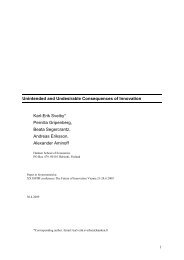Invisible Balance Sheet - Sveiby Knowledge Management
Invisible Balance Sheet - Sveiby Knowledge Management
Invisible Balance Sheet - Sveiby Knowledge Management
Create successful ePaper yourself
Turn your PDF publications into a flip-book with our unique Google optimized e-Paper software.
or insignificant, loans. Therefore, traditional financial yardsticks of solidity are<br />
not so relevant in assessing risk.<br />
Differences between them normally do not mean much in comparing knowhow<br />
companies, except in capital-intensive ones, where indicators have the<br />
same significance as for other capital-intensive enterprises.<br />
But other things being equal, a know-how company with high solidity/large<br />
equity should naturally have greater chances of surviving disturbances in the<br />
long run than a company with low solidity/little equity because of its extra<br />
buffer and presumably better credit potential.<br />
Also, though it is not necessarily so, good solidity can lead to the company’s<br />
net financial items making a positive contribution to the aggregate return. In that<br />
case, it is often evidence of the fact that the company has a large amount of<br />
structural capital.<br />
Interest cover<br />
Interest cover tells you how many times the company’s cash flow will cover<br />
actual interest costs.<br />
As external loans are often of no importance in the typical know- how<br />
company, this yardstick is of the same limited significance as other measures of<br />
solidity.<br />
Liquidity<br />
The know-how company’s solvency in the relatively short term, can determine<br />
its chances of surviving changes of personnel and in the employment situation,<br />
and also in retaining its image. This too, is what the various liquidity yardsticks<br />
try to express.<br />
Usually, they compare current assets, i.e. assets which it is considered can be<br />
realised quickly, and short-tern liabilities.<br />
Comparisons within the sector<br />
How do you know if the liquidity yardstick for a particular company is good,<br />
bad, or indifferent? Is it of real importance in assessing the risk if the company’s<br />
liquidity is acceptable, or extremely good? To answer the question it is necessary<br />
to make a comparison and the comparison closest to hand is with other<br />
companies working under similar conditions, i.e. primarily companies in the<br />
same line of business.<br />
In addition to assessing the personnel risk, it should then be possible on the<br />
basis of comparisons over time, mainly between liquidity measures for know-<br />
KAPITEL VII<br />
,59




